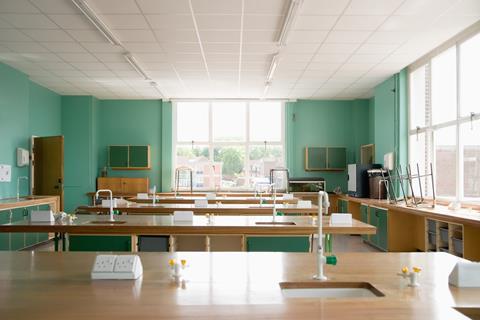Helen Rogerson shares her experiences of starting to teach chemistry online

Around the world schools are closing to prevent the spread of Covid-19. It was the closure of the schools in Italy that brought home to me the increasing likelihood of school closures in the UK. And now it’s happened.
But even before schools closed, staff sickness and self-isolation were necessitating an increase in cover and collapsed classes. It all made continuity in teaching incredibly difficult. Well-resourced departments with textbooks and booklets that students can work through independently were at an immediate advantage.
Navigating a changing landscape
At my school we quickly realised that aligning topics across a year group, and perhaps even converting to project work, would make it easier for colleagues to pick up a class comprising students from different groups. So before closure was even announced, we changed the timing of some of our modules to allow for this.
The practical aspect of the curriculum is difficult to deliver during closures though. However, there are ways around it such as data analysis tasks and simulations.
Before closure, I spent some time teaching students in front of me in the classroom at the same time as those who were already at home. This proved challenging. To reduce the workload, all the students did the same work, but those in class had the added benefit of direct intervention and support from me. Will this be the scenario for those teaching the children of keyworkers?
Avoid students (and parents) believing that teachers are available 24/7
With schools closed and exams cancelled, it’s important that students’ education continues. The best way to do it though is a school by school, department by department, even teacher by teacher decision. Schools in areas where students don’t have easy access to the internet will find it more challenging. Hopefully those facing that additional challenge have managed to organise paper-based resources for students. Fortunately, many teachers have been sharing their SLOP (shed loads of practice) booklets online to help with this – a quick Google or Twitter search and you’ll have all you need.
My school uses the Office 365 suite of apps and we already knew all students have access to a computer or iPad, so we are delivering content online. We had an afternoon of training before school closed as the timetable was already collapsed. And we’ll continue with this kind of support now that school has closed. We also encouraged teachers to use the software in the classroom so everyone was getting the hang of it before we closed. This was very useful as by experimentation with the students we found the best way of working.
Some things remain the same
With school closed, work-life balance is as important as ever. Avoiding students (and parents) believing that teachers are available 24/7 is particularly important. I intend to stick to specific ‘office’ hours for my classes, and that will be the time I would normally teach them. At this point I will upload work and respond to their emails, just as I would in a normal school week.
We are fortunate that so many science teachers have already uploaded videos to YouTube. Setting these for students to watch is a good way to present new information if you don’t want to make content yourself. Watching videos isn’t going to be enough to ensure learning continues. Checking understanding through activities still remains part of teaching.
Sharing worksheets with students is one way of doing this. Students who don’t want to complete them on a computer will need a scanner app, such as Office Lens to scan and return pieces of completed work. There’s also Google or Microsoft Forms for question sheets, and plenty of online learning platforms that automatically mark and give feedback to students.
Monitoring which students are engaged in the work and who isn’t is as important as usual, of course. Contacting tutors, heads of year and other pastoral leads to pass on concerns remain part of our work even though we’re all at home. I foresee a lot of online chat to ensure all staff stay in the loop.
Good luck everyone!
Teaching remotely is a steep learning curve. Share your experiences of navigating it so far in the comments below. And follow us on Twitter for updates.


















No comments yet